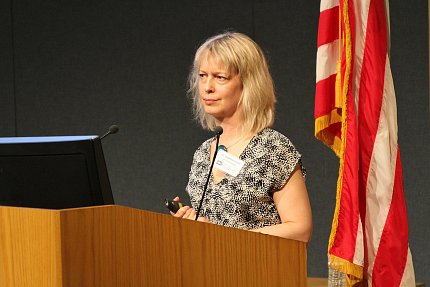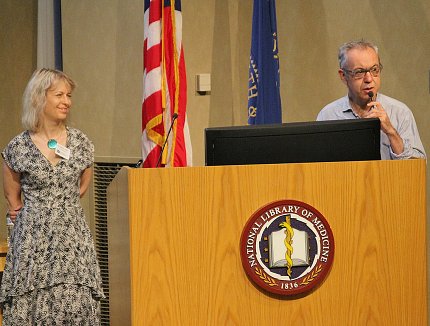Cell Press Editor Outlines Tips for Publication Success

Photo: Colleen Dundas
Dr. Deborah Sweet has served as an editor on a variety of Cell Press journals for more than a decade. She’s seen a lot during this time, including cover letters inquiring about submission that list the wrong journal name and authors who provide a suggested list of manuscript reviewers that reads, “nobody from Boston can review my paper.” Sweet highlighted publishing tips and insights for scientists during a keynote address, “Navigating Your Way to Publication Success,” at the NIAMS intramural research program’s recent annual scientific training event.
Sweet is editor-in-chief of Cell Stem Cell and has held editorial positions at Cell, Molecular Cell and Developmental Cell. She is also a publishing director at Cell Press, playing a role in overall strategic development and operational management.
“The process of successful publishing starts a long time before you ever get anywhere near your computer and start typing,” Sweet explained to researchers. She emphasized that the process involves thinking about the logic of what you’re going to say and the experiments that are needed to make the key points. She advised the audience to ask themselves, “What’s the point I’m going to make and how am I going to make it?”
Sweet stressed the importance of clear and concise writing. “When writing your paper, give it to somebody who doesn’t work in your field, such as a colleague down the corridor who works on something completely different,” she suggested. “Make sure that when they read your paper, they get out of it what you’re hoping to say. If they don’t understand it, the chances are that someone else reading it—even the editor—won’t get it either.”

Photo: Colleen Dundas
Sweet acknowledged that she gets lots of questions about whether pre-submission inquiries are useful or necessary. Such pre-submissions are optional at Cell Press, but can be a good way to get advice and feedback on whether a paper is a good fit for the journal, before going through the work of formatting it, she said. Cell Stem Cell provides an online form, which asks for information such as the abstract and a brief description of results.
The cover letter is a critical part of the submission, Sweet advised. “Explain to me what you think is interesting about your paper and where it fits in the broader context—the things that you can’t put in the abstract—and why you chose to submit it to the journal. It’s an opportunity to talk about what your paper is contributing.” Cover letters shouldn’t be more than 2 pages, she said.
Sweet highlighted three key points that editors consider when reviewing a paper: Does the paper fit within the subject scope of the journal? Is the question it addresses interesting and important? Is there a clear advance above what’s already published? The last point is the most significant, she said. “What is the conceptual advance beyond the existing literature? How far does the paper take our thinking forward?”
Once the paper is submitted, it’s assigned to an editor who reads the paper in detail and then discusses it during a team meeting. A decision is then made about whether to send it out for peer review. Selecting reviewers is a crucial step. “We think about getting the subject balance right, getting a good balance of experience and trying to introduce new reviewers. Technical coverage is very important,” Sweet explained. “We also think about consistency. If we’ve had another paper on a very similar topic, we’ll try to send it to the same reviewers so it gets the same consideration.”
Authors can provide names of suggested reviewers, as well as reviewers to exclude. “We want your paper to be reviewed fairly. If there are people who are not going to do that, please feel free to tell us,” Sweet said. “We ask you to keep it to three people. If you exclude absolutely everyone who knows about your topic, then we’ll have a really hard time finding qualified reviewers,” she said to laughter.
Sweet advised authors to wait at least 24 hours before responding to feedback from reviewers. “Read the reviews carefully, let your emotions subside, focus on the science and think about what you can do to address what’s going on,” she said. “Balance the time and effort involved in revising a paper compared to publishing someplace else and moving on to a new project.”
Sweet concluded her talk by offering a glimpse into the future of publishing. Cell Press recently introduced the STAR (Structured, Transparent, Accessible Reporting) Methods format, which is designed to increase the clarity and completeness of methods to promote rigor and reproducibility. In a nod to the growing interest in preprints, Sweet noted that some Cell Press journals recently started accepting submissions by direct transfer from bioRxiv, an online service for unpublished preprints in the life sciences.
